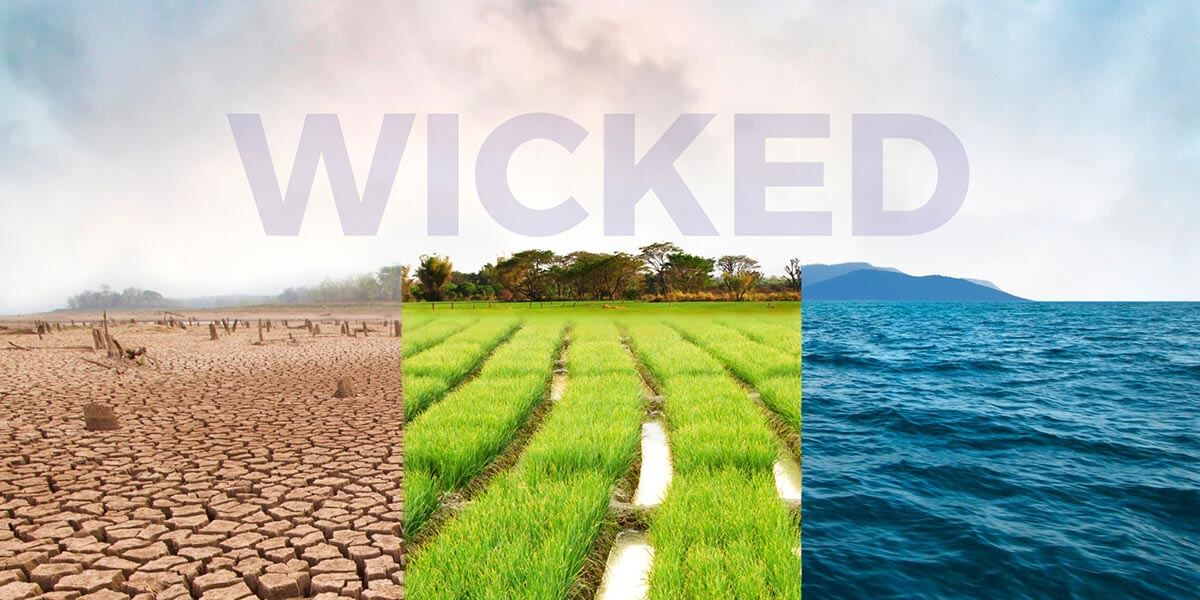In 2023, the term ‘wicked’ when applied to problems is typically reserved for discussions of Climate Change. This challenge is so complex, so daunting, so universally shared as a problem of concern, all other problems seem less significant by comparison. We have also come to understand that climate change can intensify already complex challenges like poverty, migration, drought, hunger, environmental health, refugeeism, even gender-based violence and increased conflict. As a threat and impact magnifier, climate change is certainly a ‘wicked problem’.
However, climate change is, by definition and characteristics, not the only wicked problem we’ve encountered, even if it may be the most wicked of them all in recent times. As we continue to use this conceptualization to describe challenges in global development and sustainable impact work, it is essential we have a clear understanding of what it means in actuality, and practicality.
Origins and Characteristics of Wicked Problems
This year marks the 50th anniversary of “Dilemmas in a general theory of planning” (Rittel and Webber 1973), an original and influential article in which two faculty members at the University of California at Berkeley, USA—design science professor Horst Rittel (1930–1990) and planning professor Melvin Webber (1920–2006)—presented what scholars describe as a ‘seminal conception’ of “wicked problems” (Chan and Xiang, 2022).
The introduction of the term was intended to draw attention to the complexities and challenges of addressing social policy and planning. By comparison to “tame” or simple problems in which solutions are either evident and attainable even if challenging, “wicked problems” lack clarity in both their aims and solutions.
In addition to these challenges of internal logic and articulation, “wicked problems” are subject to real-world constraints that prevent multiple and risk-free attempts at solving.
10 Shared Characteristics Of Wicked Problems
As described by Rittel and Webber, there are ten defined characteristics of wicked problems that are important to note. This includes:
- They do not have a definitive formulation.
- They do not have a “stopping rule.” In other words, these problems lack an inherent logic that signals when they are solved.
- Their solutions are not true or false, only good or bad.
- There is no way to test the solution to a wicked problem.
- They cannot be studied through trial and error. Their solutions are irreversible so, as Rittel and Webber put it, “every trial counts.”
- There is no end to the number of solutions or approaches to a wicked problem.
- All wicked problems are essentially unique.
- Wicked problems can always be described as the symptom of other problems.
- The way a wicked problem is described determines its possible solutions.
- Planners, that is those who present solutions to these problems, have no right to be wrong. Unlike mathematicians, “planners are liable for the consequences of the solutions they generate; the effects can matter a great deal to the people who are touched by those actions.”
Given these 10 characteristics, challenges like lacking access to clean water, poverty, education equality, intractable conflicts, and sustainability, not always directly linked to, but often exacerbated by climate change, are often considered wicked problems as well.
Wicked problems play out on the global, local community, and individual levels. Because there are no clear-cut fixes, proposing solutions (and challenging those solutions) often plays a prominent role politically and institutionally. As a result, these wicked problems can affect the missions and operations of governments, businesses, and organizations worldwide. And certainly, when natural resources and ecosystems are involved, the impacts of these problems and solutions may prove irreversible.
Wicked Problems Require Thoughtful and Holistic Collaboration 0n Solutions
Climate change and the challenges of sustainability exhibit most characteristics of wicked problems. Both avoid straightforward articulation, and given the flux of the systems in which they are contextualized, are impossible to solve in a way that is simple or final. They are also among the most pressing problems that organizations are actively confronting today, posing new operational challenges and demands.
In revisiting after 50 years the theoretical underpinnings of Rittel and Webber’s conceptualization of wicked problems, retrospect authors Chan and Xiang (2022) seem to suggest working with and addressing these challenges is a moral imperative.
Through “Dilemmas”, they note, “Horst Rittel and Melvin Webber present a persuasive case that calls for practitioners, scholars, and the general public to attend to the daunting social reality of wicked problems.” This includes advocating for what has later been referred to as the Triple-A Strategy that includes the following:
- awareness — to raise a general awareness about the ubiquity of wicked problems.
- acceptance — to commit to an honest acceptance of the intractability and insolubility of wicked problems.
- adaptation — to stand up to the challenges of wicked problems with innovative adaptation strategies and approaches.
In ideological and practical terms, the response to these wicked problems is what Resonance co-founder and Chief Innovation Officer (CIO) Steve Schmida calls "the wicked new normal," and organizations are forging ahead by embracing “breakpoint” change through the establishment of goals, commitments, and initiatives across supply and value chains.
There is no recipe or set of protocols you can use to solve a wicked problem. A wicked problem has economic, social, and environmental dimensions that interact with one another in ways that are ever-changing and unpredictable. As a result, many wicked problems are never completely solved. Instead, the best one can hope for is a process of continual improvement in addressing the issue - Steve Schmida in Partner with a Purpose.
Indicative of the characteristics of wicked problems, there are often endless possible solutions to consider, many addressing both unique regional factors as well as anticipated and unexpected consequences and impacts locally, regionally, and globally.
Thus in order to be able to tackle these challenges, our changing conversations around climate science and sustainability, as well as related concepts like mitigation, adaptation, resilience, and regeneration, may require discussions of holistic, collaborative approaches, including proactive cross-sector partnership design, in order to address solutions now and in the future.
To learn more about the Characteristics of Wicked Problems as first defined, read the work of Rittel, H. W., & Webber, M. M. (1973). "Dilemmas in a General Theory of Planning." Policy sciences, 4(2), 155-169. Abstract and Access Linked Here.
Read also a retrospective of the impacts of Rittel and Webber's conceptualization of Wicked Problems over the last 50 years since it was published in "Dilemmas," in the recently-published article (Citation) -- Chan, J.K.H., Xiang, WN. Fifty years after the wicked-problems conception: its practical and theoretical impacts on planning and design. Socio Ecol Pract Res 4, 1–6 (2022). https://doi.org/10.1007/s42532-022-00106-w Linked Here.
Editor’s Note: This post has been updated for accuracy and current best practices.



